Something to chew on, for kids that can’t stop
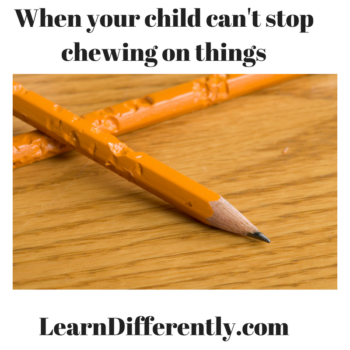
By Kathy Kuhl Do you have children who can’t stop chewing on things?
Kids and teens with sensory issues and other issues may struggle with this—or give in to it without a thought. No matter how well they know that pencil has been handled by many people, it pops into their mouths. And if it not a pencil-chewing problem, perhaps you have a child or teen who cannot stop nibbling on nails, knuckles, or cuticles.
Habits like these can be a result of stress, because they can soothe. Your child may be seeking sensory stimulation. A child on the spectrum may find chewing on something a soothing repetitive behavior, also known as “stimming.” (Hand flapping is probably the best-known way of stimming.) Chewing can also be a symptom of Tourettes.
From my desk here, I cannot diagnose your child—even if I was qualified to! But whatever the reason, and whether they chew on pens, fingernails, or hoodie drawstrings, your child or teen can be ridiculed. They can also ingest germs or even choke, if they chew on something that breaks into small pieces.

Maybe it’s just a stage?
If your kids don’t struggle with this issue now, realize that it can appear at different ages. My son didn’t chew on things much as a tot. But at age seven, the chewing habit began when he joined a soccer team.
Like his young teammates, he alternated between standing aimlessly in his part of the field, and joining the flock of children swarming the ball like bees. When he was bored, there was nothing to fiddle with except his sweatshirt cuffs, and eventually, chew them.
At the end of the season, every child received a certificate of recognition. My son’s was for “Best high-fiber diet.” As ridicule goes, it was pretty mild. My seven-year-old didn’t get it, for which I’m glad. But I was angry.
Leaving that field, he quickly outgrew the problem. But many of our kids don’t stop.
What can we do?
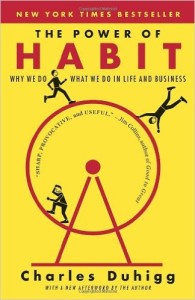
In my review on Charles Duhigg’s book, The Power of Habit, I talk about breaking habits. Duhigg explains the best way to break a habit is by replacing an unwanted behavior with a better behavior. One way is to find things your child or teen can safely and discretely chew in public.
Gum
If your child is old enough not to swallow it, gum may be a good option. I don’t like my kids’ teeth to be soaked in extra sugar, and aspartame (as in Nutrasweet or Equal) gives us headaches. (Nutritional therapy practitioner Beverly Seng was the first to explain to our homeschool group that it’s toxic. See link in this post’s Resource section.)
It’s been a struggle to find gum without artificial sweeteners; they almost all have it. Finally I found one, sweetened with a plant extract called xylitol. The American Dental Association states that chewing xylitol gum after meals can help prevent cavities. (See resources at end of this post.)
I’ve tried a few brands and flavors. Zellie’s gum is the best I’ve found so far for gum sweetened with xylitol instead of sugar or aspartame. It comes in spearmint, cinnamon, cool peppermint, and fruit.
The flavors don’t last as long as regular gum, but these bottles of 100 pieces of gum are more economical than regular packs, that I don’t mind getting a second piece later.
Other chewable items
Several companies make sensory products designed to be chewed on. Before you buy, double-check to see that what you buy is made of safe FDA-approved materials. Chewable non-food items are sold by many organizations; see the resource section below.
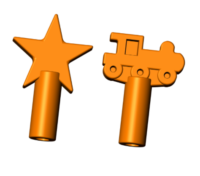
Pencil toppers
These can be chewed on fairly discretely. It doesn’t look much different form chewing on a pencil. Chew Stixx makes several varieties. The star- and train- shaped ones come in different colors and flavors,as well as less juvenile designs that resemble pencil grips, smooth or textured.
You child may have strong preferences about texture. None of the pencil toppers are for kids under 3.

One of Chewigem’s many styles and colors of necklaces.
Chewable jewelry
This is clever: disguise your chewable object as something attractive to wear.
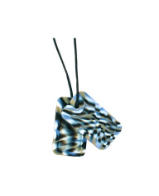
Chewigem’s dog tag necklace in camo, among other colors.
These are not all feminine. There are brick designs and dog tags and dinosaur track shapes. There are several brands, listed under resources below. Materials vary; some necklaces and other products are sturdy enough for kids who chew hard, others are made for light to moderate chewers.
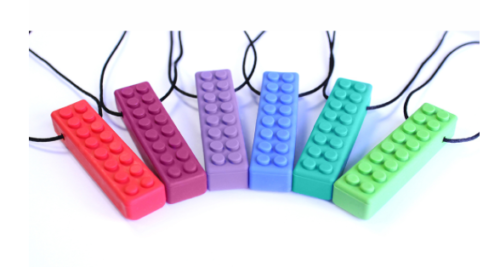
Brick Stick Chew Necklaces by Ark Therapeutic Products
Another option, for young children, is this terrycloth necklace decorated with an elephant.

Chewable fidgets and many other sensory solutions
Many companies make different toys and fidgets that can safely be chewed on. Chewy tubes are shaped like the letter T, the top being a handle to hold while chewing on the stem.

Chewy tubes come in different colors and textures.
Stems can be smooth or ribbed. They are 3/8” wide. Chew Stixx makes other models your child may prefer
Share your ideas
What strategies and products do you use to help your child who chews on things? Please share int the comments section below. Thank you.
Resources
Articles on the toxicity of aspartame is available from Beverly Seng’s Its-Altimentary.com here. She has retired from her nutritional therapy practice, but now gives presentations about preventing and alleviating dementia.
The American Dental Association chewing xylitol gum after meals can help prevent cavities.
Zellie’s gum is the best I’ve found so far for gum with xylitol, instead of sugar or aspartame.
Pencil toppers are sold on Amazon and at Sensory University.
Chewable jewelry, and other sensory products:
including chew tubes, weighted stuffed animals, weights vests, blankets:
- Ark Therapeutic Products makes many necklaces, among other products
- Chewigem,
- Kidcompanions,
- National Autism Resources, which has cloth wristbands, and
- School Speciality’s Abilitations division sells many sensory products.


